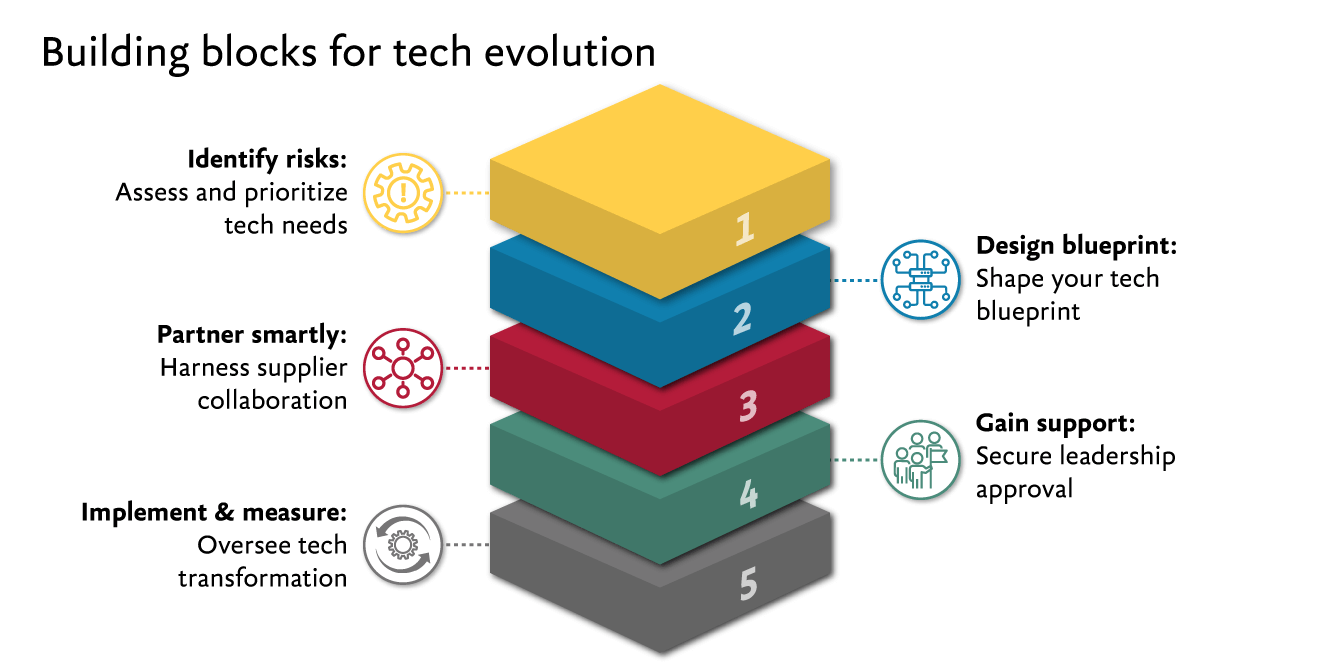Are your legacy systems increasingly unfit for purpose? Are you facing spiralling support costs just to keep the lights on, let alone deliver your strategic priorities? You’re not alone. Our experience suggests that a tangled web of clunky and costly legacy tech is the operational reality for most large, long-established organizations.
So how can you turn your systems from a deadweight to a strategic driver? In the first in our series on how to cut through the complexities of legacy tech transformation, we look at how understanding your tech estate and the scale of risk you carry can provide the vital first step towards smart, targeted modernization.
What should the future state of technology look like?
The aspiration is agile, responsive and innovative tech capabilities, but most organizations struggle to get by with a creaking IT estate. Even digital leaders spend most of their technology budgets on upkeep rather than modernization and innovation.
Little wonder then that so many clients ask us, “How can we sort out our legacy systems?”
The challenges of updating legacy technology
So why is reliance on legacy systems still so prevalent and hard to overcome?
The costs of modernization can hold back many organisations, though with good targeting, planning and execution, these can be contained.
Potentially more debilitating is the challenge of unravelling and replacing legacy systems that have been layered on top of each other or patched together over decades. The results are often likened to an overgrown garden. But unlike a garden, you can’t just cut your tech estate back, replant it and watch it grow. You also have to find a way to keep operations running while the contractors are at work. While the need to limit the risk of operational breakdowns and outages is always pressing, it is especially acute within organizations delivering critical national infrastructure in areas ranging from payments systems to water, energy and air traffic control.
The challenges are compounded by the fact that your legacy estate isn’t just made up of multiple applications. These applications depend on a plethora of operating systems, networks and infrastructure, along with all the workarounds, manual interventions and key personnel needed to keep them running as best they can. Critical services often depend on decades-old legacy technology.
A piecemeal approach to digital transformation
As each year passes, the daunting enormity of transformation builds up. Leadership teams can easily conclude that it’s better to make do and mend or pass the problem to their successors, rather than face all the risks and upheaval that can come with systems overhaul. So, many organizations spend a substantial amount of their time and budget on maintaining legacy technology.
Even where modernization is pursued, it can often focus on surface upgrades or the latest fads, leaving core systems to splutter on as before. We’ve seen instances where companies have introduced state-of-the-art technology in areas such as pricing or customer engagement, for example. But their billing still relies on slow, inflexible and hard to scale capabilities, dating back 20 years or more.
Unsustainable legacy drain
The problem is that endlessly making do and mending is unsustainable.
Over time, functionality either deteriorates or fails to keep up with business demands, making it more and more difficult for staff to do their jobs properly. One client came to us because an independent review had found serious deficiencies in the data and systems it was using within its critical forecasting and analysis – a fundamental risk to their organization.
There are other risks to consider – and the cost of inaction too. As warranties expire or software is no longer supported, organizations find that they have to rely on expensive third-party contracts to keep critical IT running. The few key personnel who know how the systems work might also have left the organization and therefore have to be brought back in at much higher rates as contractors.
When a system is no longer supported, functional and security updates also cease. The results can not only undermine the operational reliability of critical systems, but also heighten the risk of damaging cyberattacks and data breaches.
The other big challenge is how to attract and retain talent. People want to be working with the latest tech, want the same kind of easy and accessible functionality they’ve become accustomed to in their personal devices. Being forced to rely on legacy technology at work is therefore a turn off.
Laying the groundwork for modernizing legacy technology
The good news is that with an informed and structured approach, you can stabilize, optimize and eventually modernize your legacy tech capabilities. We’ve learned this from working with organizations operating a wide range of critical national infrastructure.

In the coming articles in this series, we’ll be drawing on our experience to set out the building blocks for lasting and successful change:
- Targeted modernization: Mapping your tech, measuring the risk and maximizing the impact. How to ensure you have the data on the obsolescence risks within your legacy estate and priorities for action needed to direct tech investment where it really counts.
- Beyond the blueprint: How enterprise architecture shapes your tech operating model. How to configure your tech operating model to ensure that your systems capabilities deliver your strategic ambitions.
- Smart tech partnering: Buying intelligently on the journey from legacy to leading-edge. How to make effective use of partnerships to secure tech skills and access to the latest systems needed to drive modernization.
- Securing leadership buy-in: Making a compelling case for modernization. How to demonstrate the importance of technology in delivering your strategic ambitions and how to anchor investment decisions in clear, credible and compelling data.
- From vision to value: Mobilizing, managing, and measuring your legacy tech transformation. How a ‘watchtower’ capability could help you to take control of your legacy tech estate over the long-term and balance the demands of maintenance and modernization in an assured and proactive way.
Let’s talk
We’re working with businesses across all sectors to help them sustain operations and cut through the complexities of legacy tech transformation. Contact us if you’d like to know more.










